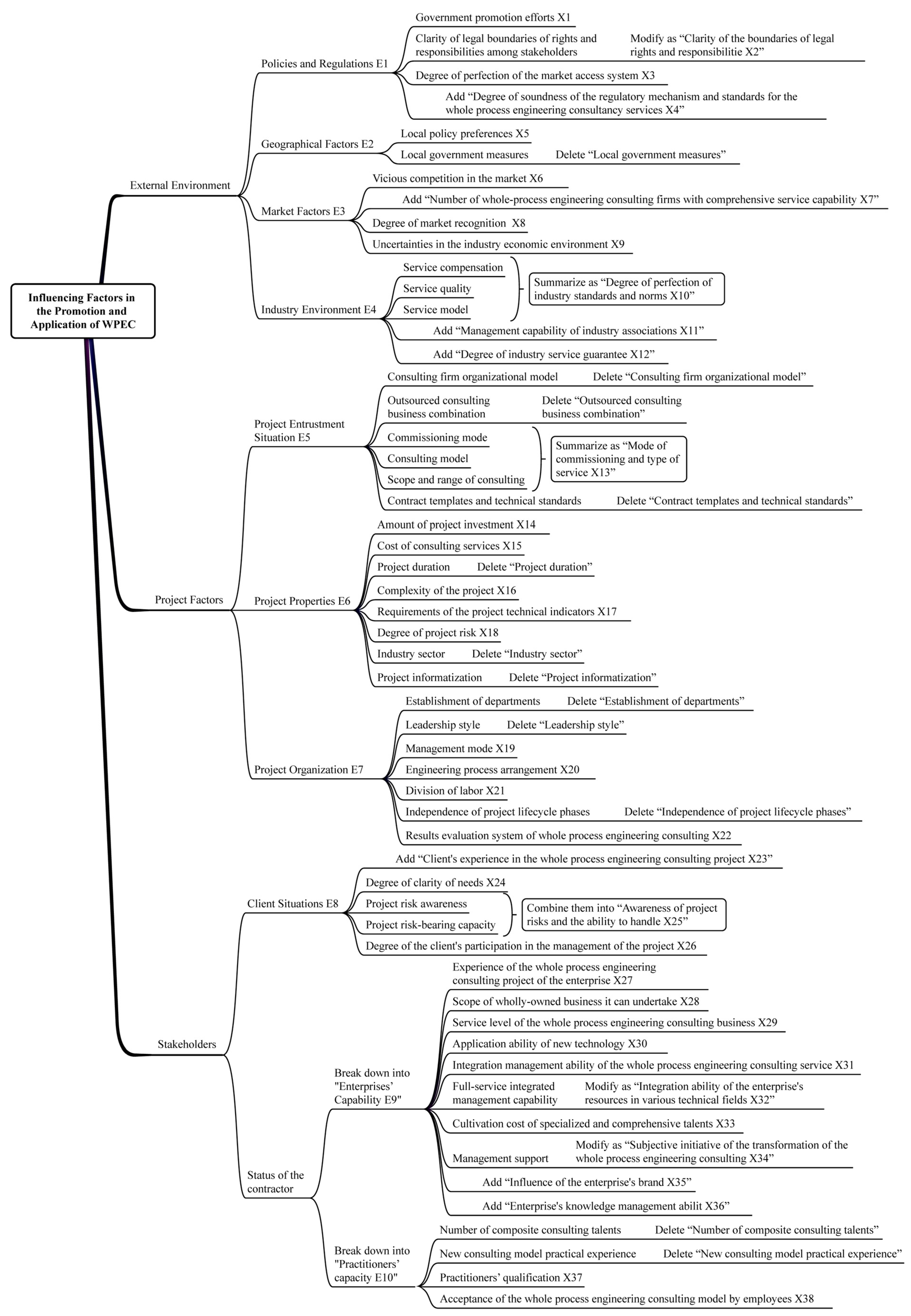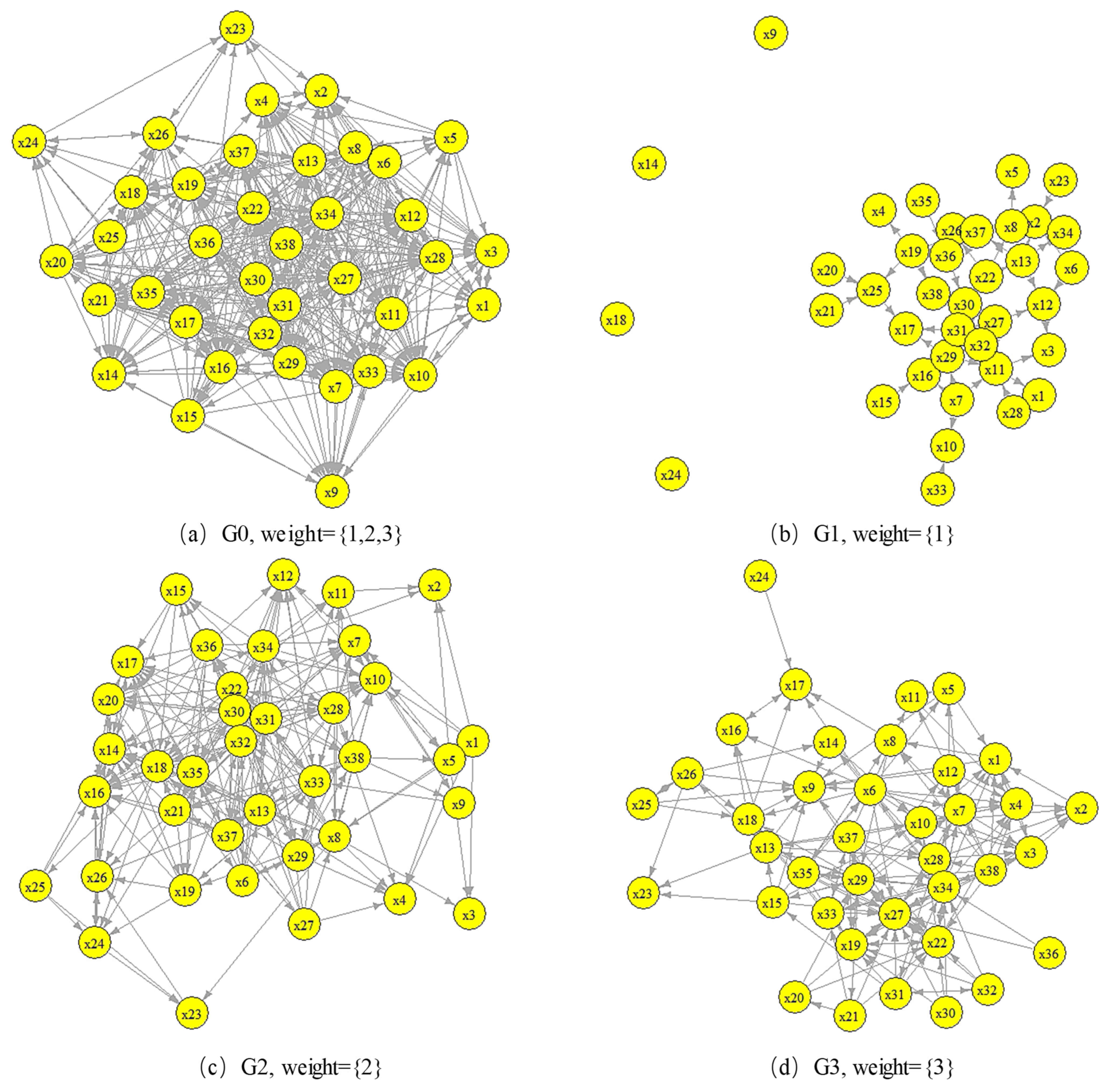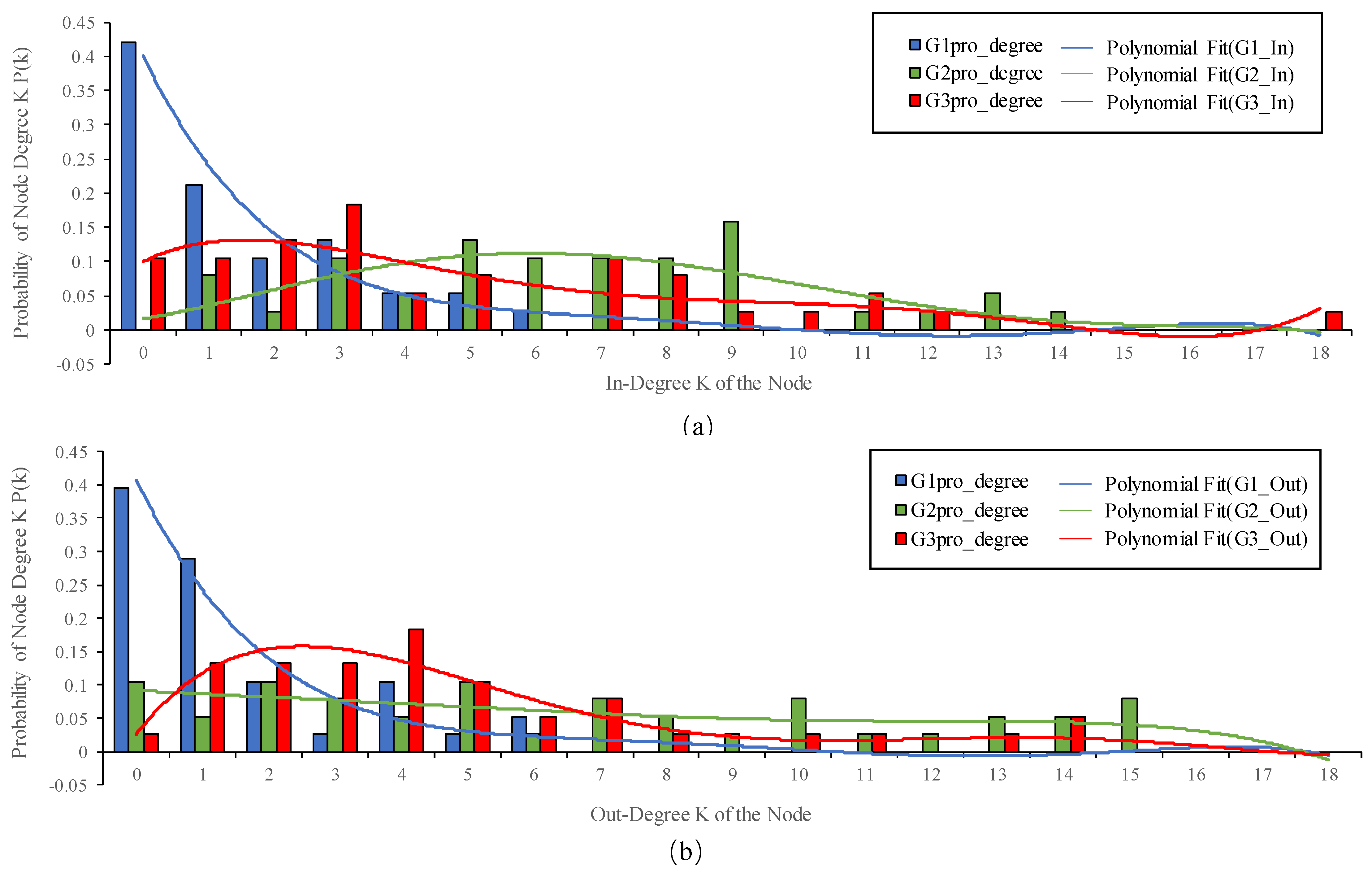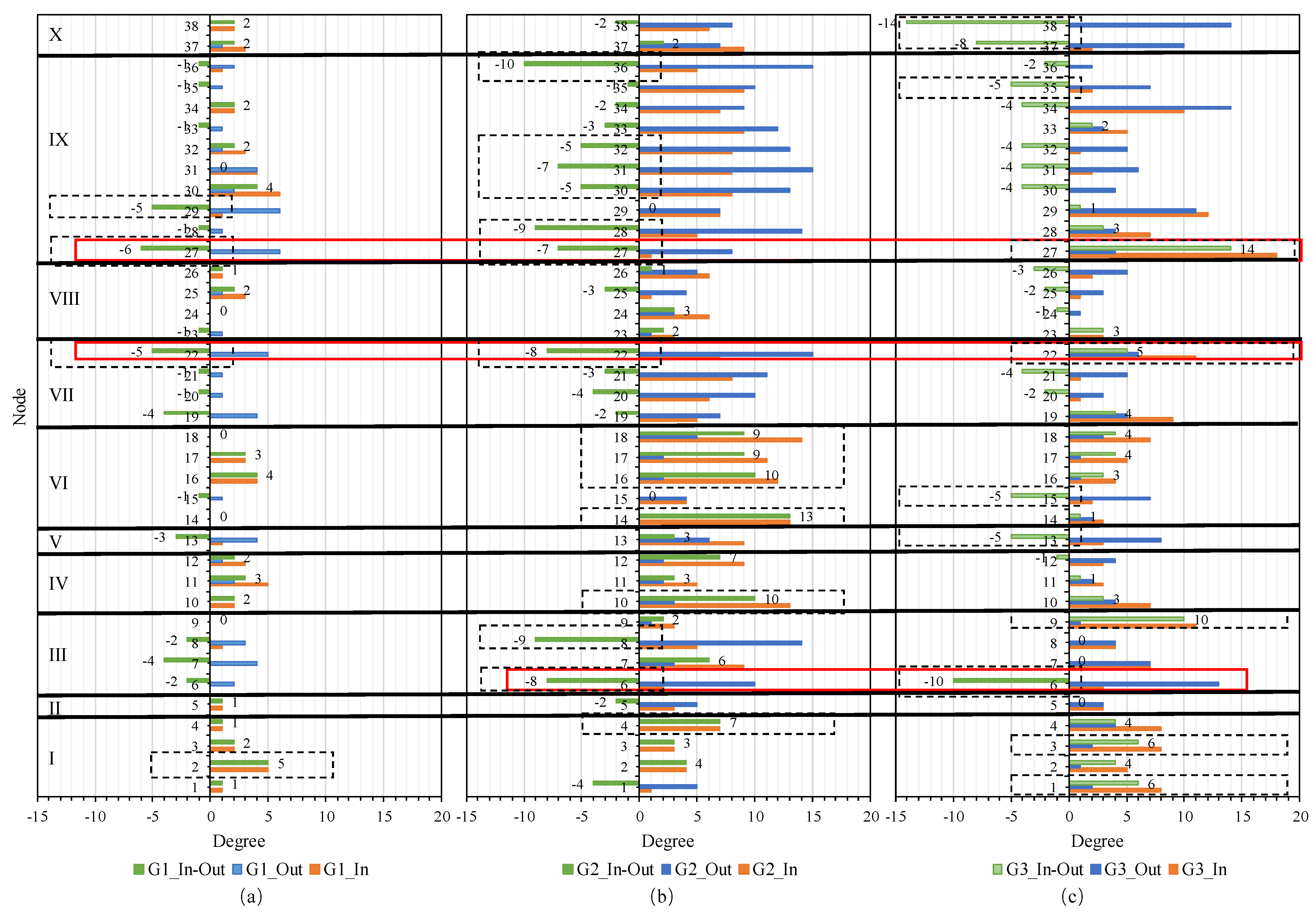Transmission Mechanism of Influencing Factors in the Promotion and Application of Whole-Process Engineering Consulting
Abstract
:1. Introduction
2. Methodology
2.1. Research Framework
2.2. Identification of Influencing Factors in the Promotion and Application of WPEC
2.3. Network Construction
2.4. Network Structure Analysis
3. Results
3.1. Node In-Degree, Out-Degree, and Difference Analysis
3.2. Node Degree Value Correlation Analysis
3.3. Motif Analysis
4. Discussions
5. Conclusions
Author Contributions
Funding
Data Availability Statement
Conflicts of Interest
Appendix A. Survey on Influencing Factors for the Promotion and Application of Whole-Process Engineering Consulting
- Part One: Basic Information
- Date of Birth: ____Year___Month___Day
- Current City of Employment: ________
- Gender: □ Male □ Female
- Years of Work Experience: □ Less than 1 year □ 1–3 years □ 4–6 years □ 7–9 years □ 10 years and above
- Job Category: □ General Staff □ Junior Management □ Middle Management □ Senior Management □ Professional Technical Staff
- Nature of Your Organization: □ State-owned Enterprise □ Private Enterprise □ Foreign-funded Enterprise □ Public Institution □ Others
- Your Understanding of Whole-Process Engineering Consulting: □ Not Familiar □ Somewhat Familiar □ Basically Familiar □ Very Familiar
- Part Two: Evaluation of Agreement on Influencing Factors for the Promotion and Application of Whole-Process Engineering Consulting
- 1.
- External Environment, including:(1) Policies and Regulations: ➀ Government’s promotion efforts ➁ Clarity of the boundaries of legal rights and responsibilities ➂ Degree of perfection of the market access system ➃ Degree of soundness of the regulatory mechanism and standards for the whole-process engineering consultancy services□ Strongly Disagree □ Disagree □ Neutral □ Agree □ Strongly AgreeIf you disagree, please provide your suggestions:______________________________________________________(2) Regional Factors: ➀ Local policy preference□ Strongly Disagree □ Disagree □ Neutral □ Agree □ Strongly AgreeIf you disagree, please provide your suggestions:______________________________________________________(3) Market Factors: ➀ Vicious competition in the market ➁ Number of whole-process engineering consulting firms with comprehensive service capability ➂ Degree of market recognition ➃ Uncertainties in the industry economic environment□ Strongly Disagree □ Disagree □ Neutral □ Agree □ Strongly AgreeIf you disagree, please provide your suggestions:______________________________________________________(4) Industry Environment: ➀ Degree of perfection of industry standards and norms ➁ Management capability of industry associations ➂ Degree of industry service guarantee□ Strongly Disagree □ Disagree □ Neutral □ Agree □ Strongly AgreeIf you disagree, please provide your suggestions:______________________________________________________
- 2.
- Project Factors, including:(1) Project Commissioning Situation: ➀ Mode of commissioning and type of service□ Strongly Disagree □ Disagree □ Neutral □ Agree □ Strongly AgreeIf you disagree, please provide your suggestions:______________________________________________________(2) Project Nature: ➀ Amount of project investment ➁ Cost of consulting services ➂ Complexity of the project ➃ Requirements of the project technical indicators ➄ Degree of project risk□ Strongly Disagree □ Disagree □ Neutral □ Agree □ Strongly AgreeIf you disagree, please provide your suggestions:______________________________________________________(3) Project Organization Situation: ➀ Management mode ➁ Engineering process arrangement ➂ Division of labor ➃ Results evaluation system of whole process engineering consulting□ Strongly Disagree □ Disagree □ Neutral □ Agree □ Strongly AgreeIf you disagree, please provide your suggestions:______________________________________________________
- 3.
- Stakeholders, including the situation of the commissioning party and the undertaking party.(1) Situation of the Commissioning Party, including: ➀ Client’s experience in the whole process engineering consulting project ➁ Degree of clarity of needs ➂ Awareness of project risks and the ability to handle ➃ Degree of the client’s participation in the management of the project□ Strongly Disagree □ Disagree □ Neutral □ Agree □ Strongly AgreeIf you disagree, please provide your suggestions:______________________________________________________(2) Situation of the Undertaking Party, including enterprise capabilities and personnel capabilities.(2.1) Enterprise Capabilities, including: ➀ Experience of the whole process engineering consulting project of the enterprise ➁ Scope of wholly-owned business it can undertake ➂ Service level of the whole process engineering consulting business ➃ Application ability of new technology ➄ Integration management ability of the whole process engineering consulting service ➅ Integration ability of the enterprise’s resources in various technical fields ➆ Cultivation cost of specialized and comprehensive talents ➇ Subjective initiative of the transformation of the whole process engineering consulting ➈ Influence of the enterprise’s brand ➉ Enterprise’s knowledge management ability□ Strongly Disagree □ Disagree □ Neutral □ Agree □ Strongly AgreeIf you disagree, please provide your suggestions:______________________________________________________(2.2) Personnel Capabilities, including: ➀ Practitioners’ qualification ➁ Acceptance of the whole process engineering consulting model by employees□ Strongly Disagree □ Disagree □ Neutral □ Agree □ Strongly AgreeIf you disagree, please provide your suggestions:______________________________________________________
- Part Three: Evaluation of the Degree of Association Among Influencing Factors for the Promotion and Application of Whole-Process Engineering Consulting
- X1:
- Government’s promotion efforts
- X2:
- Clarity of the boundaries of legal rights and responsibilities
- X3:
- Degree of perfection of the market access system
- X4:
- Degree of soundness of the regulatory mechanism and standards for the whole process engineering consultancy services
- X5:
- Local policy preference
- X6:
- Vicious competition in the market
- X7:
- Number of whole-process engineering consulting firms with comprehensive service capability
- X8:
- Degree of market recognition
- X9:
- Uncertainties in the industry economic environment
- X10:
- Degree of perfection of industry standards and norms
- X11:
- Management capability of industry associations
- X12:
- Degree of industry service guarantee
- X13:
- Mode of commissioning and type of service
- X14:
- Amount of project investment
- X15:
- Cost of consulting services
- X16:
- Complexity of the project
- X17:
- Requirements of the project technical indicators
- X18:
- Degree of project risk
- X19:
- Management mode
- X20:
- Engineering process arrangement
- X21:
- Division of labor
- X22:
- Results evaluation system of whole process engineering consulting
- X23:
- Client’s experience in the whole process engineering consulting project
- X24:
- Degree of clarity of needs
- X25:
- Awareness of project risks and the ability to handle
- X26:
- Degree of the client’s participation in the management of the project
- X27:
- Experience of the whole process engineering consulting project of the enterprise
- X28:
- Scope of wholly-owned business it can undertake
- X29:
- Service level of the whole process engineering consulting business
- X30:
- Application ability of new technology
- X31:
- Integration management ability of the whole process engineering consulting service
- X32:
- Integration ability of the enterprise’s resources in various technical fields
- X33:
- Cultivation cost of specialized and comprehensive talents
- X34:
- Subjective initiative of the transformation of the whole process engineering consulting
- X35:
- Influence of the enterprise’s brand
- X36:
- Enterprise’s knowledge management ability
- X37:
- Practitioners’ qualification
- X38:
- Acceptance of the whole-process engineering consulting model by employees
| X1 | X2 | X3 | X4 | X5 | X6 | X7 | X8 | X9 | X10 | X11 | X12 | X13 | X14 | X15 | X16 | X17 | X18 | X19 | X20 | X21 | X22 | X23 | X24 | X25 | X26 | X27 | X28 | X29 | X30 | X31 | X32 | X33 | X34 | X35 | X36 | X37 | X38 | |
| X1 | ||||||||||||||||||||||||||||||||||||||
| X2 | ||||||||||||||||||||||||||||||||||||||
| X3 | ||||||||||||||||||||||||||||||||||||||
| X4 | ||||||||||||||||||||||||||||||||||||||
| X5 | ||||||||||||||||||||||||||||||||||||||
| X6 | ||||||||||||||||||||||||||||||||||||||
| X7 | ||||||||||||||||||||||||||||||||||||||
| X8 | ||||||||||||||||||||||||||||||||||||||
| X9 | ||||||||||||||||||||||||||||||||||||||
| X10 | ||||||||||||||||||||||||||||||||||||||
| X11 | ||||||||||||||||||||||||||||||||||||||
| X12 | ||||||||||||||||||||||||||||||||||||||
| X13 | ||||||||||||||||||||||||||||||||||||||
| X14 | ||||||||||||||||||||||||||||||||||||||
| X15 | ||||||||||||||||||||||||||||||||||||||
| X16 | ||||||||||||||||||||||||||||||||||||||
| X17 | ||||||||||||||||||||||||||||||||||||||
| X18 | ||||||||||||||||||||||||||||||||||||||
| X19 | ||||||||||||||||||||||||||||||||||||||
| X20 | ||||||||||||||||||||||||||||||||||||||
| X21 | ||||||||||||||||||||||||||||||||||||||
| X22 | ||||||||||||||||||||||||||||||||||||||
| X23 | ||||||||||||||||||||||||||||||||||||||
| X24 | ||||||||||||||||||||||||||||||||||||||
| X25 | ||||||||||||||||||||||||||||||||||||||
| X26 | ||||||||||||||||||||||||||||||||||||||
| X27 | ||||||||||||||||||||||||||||||||||||||
| X28 | ||||||||||||||||||||||||||||||||||||||
| X29 | ||||||||||||||||||||||||||||||||||||||
| X30 | ||||||||||||||||||||||||||||||||||||||
| X31 | ||||||||||||||||||||||||||||||||||||||
| X32 | ||||||||||||||||||||||||||||||||||||||
| X33 | ||||||||||||||||||||||||||||||||||||||
| X34 | ||||||||||||||||||||||||||||||||||||||
| X35 | ||||||||||||||||||||||||||||||||||||||
| X36 | ||||||||||||||||||||||||||||||||||||||
| X37 | ||||||||||||||||||||||||||||||||||||||
| X38 |
References
- Shi, H.; Zhang, R.; Xie, P. Development status and trend of the whole process engineering consulting. For. Chem. Rev. 2022, 5, 1265–1270. [Google Scholar]
- Wang, Z.H. Expression of concepts and terms related to whole process engineering consulting. Eng. Constr. 2022, 36, 258–260. [Google Scholar]
- Huang, Y. Research on the Development of Whole Process Engineering Consulting Based on Policy Analysis and Multi Project Statistics. Constr. Econ. 2022, 43, 19–28. [Google Scholar]
- Zhang, S.; Sun, K. The whole process consulting integrated management analysis based on virtual value chain. J. Eng. Manag./Gongcheng Guanli Xuebao 2019, 33, 28–36. [Google Scholar]
- Zhuo, S.; Liang, B.; Wang, C.; Zhang, T. Analysis of social capital and the whole-process engineering consulting company’s behavior choices and government incentive mechanisms—Based on replication dynamic evolutionary game theory. Buildings 2023, 13, 1604. [Google Scholar] [CrossRef]
- Liao, Z. Application analysis of whole-process engineering consulting service in ppp project management. Munic. Engineering. 2022, 7, 31–38. [Google Scholar]
- Zhu, X.; Shen, S.; Liu, C. Path analysis of implementing whole process engineering consulting mode in power grid project. In Proceedings of the 2021 International Conference on Applications and Techniques in Cyber Intelligence: Applications and Techniques in Cyber Intelligence (ATCI 2021), Fuyang, China, 19–21 June 2021; Volume 2, pp. 79–85. [Google Scholar]
- Shen, Z.; Zhao, J.; Guo, M. Evaluating the engineering-procurement-construction approach and whole process engineering consulting mode in construction projects. Iran. J. Sci. Technol. Trans. Civ. Eng. 2023, 47, 2533–2547. [Google Scholar] [CrossRef]
- Xie, W. Analysis on Influencing Factors of the Implementation of Whole Process Engineering Consulting Based on DEMATEL Model. China Build. Decor. 2022, 32, 95–97. [Google Scholar]
- Xu, Y.; Wen, X.; Ma, S. Analysis on Barrier Factors of the Implementation of Whole Process Engineering Consulting Based on ISM Model. Constr. Econ. 2022, 43, 81–89. [Google Scholar]
- Hu, Q.G.; Tian, X.Z.; He, Z.M. Analysis of influencing factors consulting mode in promotion of whole-process engineering based on DEMATEL-ISM. J. Chang. Univ. Sci. Technol. 2021, 18, 40–48. [Google Scholar]
- Bürger, M.; Schlögl, S.; Schmid-Petri, H. Conflict dynamics in collaborative knowledge production. A study of network gatekeeping on Wikipedia. Soc. Netw. 2023, 72, 13–21. [Google Scholar] [CrossRef]
- Völker, B. Networks in lockdown: The consequences of COVID-19 for social relationships and feelings of loneliness. Soc. Netw. 2023, 72, 1–12. [Google Scholar] [CrossRef] [PubMed]
- Aerne, A. Prestige in social dilemmas: A network analytic approach to cooperation among Bogotá’s art organizations. Soc. Netw. 2020, 61, 196–209. [Google Scholar] [CrossRef]
- Zhang, Z.; Luo, T. Network capital, exploitative and exploratory innovations—From the perspective of network dynamics. Technol. Forecast. Soc. Change 2020, 152, 119910. [Google Scholar] [CrossRef]
- Huang, X.; Hu, Q.; Peng, Y.; Huang, K.; Liao, X.; Zhou, L. Influencing Factors and Transmission Mechanisms of the Application and Promotion of Whole-Process Engineering Consulting Based on Complex Networks. In Proceedings of the 2023 9th International Conference on Big Data and Information Analytics (BigDIA), Haikou, China, 15–17 December 2023; pp. 398–408. [Google Scholar]
- Zhou, W.; Chen, W.; Wang, Z.; Ma, Y. Generating Behavior in the University-Industry Collaboration Network: Based on the Configuration of Motifs. J. Syst. Sci. Inf. 2015, 3, 434–450. [Google Scholar] [CrossRef]
- Hu, B.R.; Pei, Z.M.; Luo, Z.K. Temporal network motif discovery method based on null model. J. Comput. Appl. 2023, 43, 2505–2510. [Google Scholar]
- Yu, S.; Feng, Y.; Zhang, D.; Bedru, H.D.; Xu, B.; Xia, F. Motif discovery in networks: A survey. Comput. Sci. Rev. 2020, 37, 100267. [Google Scholar] [CrossRef]
- Bejan, A.V.; Errera, M.R. Complexity, organization, evolution, and constructal law. J. Appl. Phys. 2016, 119, 074901. [Google Scholar] [CrossRef]
- Freire, L.O.; de Andrade, D.A. Constructal Law of Institutions within Social Organizations. Open J. Appl. Sci. 2018, 8, 103–125. [Google Scholar] [CrossRef]







| Subgraph Number | Subgraph Structure | Subgraph (Motif r = 1000, p < 0.01, Z > 0) | Subgraph Types | ||||
|---|---|---|---|---|---|---|---|
| Frequency [Original] | Mean-Freq [Random] | Standard-Dev [Random] | Z-Score | p-Value | |||
| 38 |  | 12.274% | 9.875% | 0.005 | 4.799 | 0 | G2-3motif |
| 10.357% | 8.095% | 0.006 | 3.494 | 0 | G3-3motif | ||
| 46 |  | 3.571% | 2.640% | 0.003 | 3.609 | 0 | G2-3motif |
| 1.953% | 1.138% | 0.003 | 3.234 | 0.001 | G3-3motif | ||
| 166 |  | 2.971% | 1.318% | 0.003 | 5.647 | 0 | G3-3motif |
| 12 |  | 23.260% | 21.574% | 0.006 | 2.793 | 0 | G3-3motif |
| 590 |  | 2.213% | 0.435% | 0.004 | 4.517 | 0 | G1-4motif |
| 1.004% | 0.498% | 0.001 | 3.601 | 0.001 | G3-4motif | ||
| 4558 |  | 0.121% | 0.022% | 0.000 | 7.480 | 0 | G2-4motif |
| 2182 |  | 1.273% | 0.723% | 0.001 | 5.212 | 0 | G2-4motif |
| 2252 |  | 0.802% | 0.463% | 0.001 | 4.875 | 0 | G2-4motif |
| 972 |  | 0.362% | 0.170% | 0.000 | 4.834 | 0 | G2-4motif |
| 2190 |  | 0.718% | 0.427% | 0.001 | 4.760 | 0 | G2-4motif |
| 2270 |  | 0.259% | 0.106% | 0.000 | 4.696 | 0 | G2-4motif |
| 0.125% | 0.019% | 0.000 | 6.339 | 0 | G3-4motif | ||
| 74 |  | 9.044% | 7.380% | 0.004 | 4.622 | 0 | G2-4motif |
| 2462 |  | 0.278% | 0.115% | 0.000 | 4.562 | 0 | G2-4motif |
| 17,356 |  | 0.090% | 0.026% | 0.000 | 4.553 | 0.001 | G2-4motif |
| 8908 |  | 0.151% | 0.060% | 0.000 | 4.167 | 0 | G2-4motif |
| 2458 |  | 0.585% | 0.347% | 0.001 | 4.133 | 0 | G2-4motif |
| 2254 |  | 0.543% | 0.277% | 0.001 | 4.110 | 0.001 | G2-4motif |
| 670 |  | 0.452% | 0.242% | 0.001 | 3.977 | 0.001 | G2-4motif |
| 19,102 |  | 0.048% | 0.013% | 0.000 | 3.938 | 0.004 | G2-4motif |
| 2118 |  | 1.919% | 1.359% | 0.001 | 3.844 | 0.001 | G2-4motif |
| 2140 |  | 0.766% | 0.474% | 0.001 | 3.802 | 0 | G2-4motif |
| 19,034 |  | 0.139% | 0.052% | 0.000 | 3.745 | 0 | G2-4motif |
| 924 |  | 0.326% | 0.176% | 0.000 | 3.519 | 0.001 | G2-4motif |
| 5070 |  | 0.054% | 0.019% | 0.000 | 3.354 | 0.002 | G2-4motif |
| 142 |  | 3.873% | 3.349% | 0.002 | 3.339 | 0.001 | G2-4motif |
| 2758 |  | 0.181% | 0.087% | 0.000 | 3.034 | 0.004 | G2-4motif |
| 0.183% | 0.058% | 0.000 | 3.561 | 0.005 | G3-4motif | ||
| 2134 |  | 0.555% | 0.345% | 0.001 | 3.007 | 0.004 | G2-4motif |
| 0.411% | 0.143% | 0.001 | 4.645 | 0.001 | G3-4motif | ||
| 222 |  | 0.386% | 0.216% | 0.001 | 2.977 | 0.001 | G2-4motif |
| 2142 |  | 0.501% | 0.329% | 0.001 | 2.963 | 0.003 | G2-4motif |
| 18,590 |  | 0.103% | 0.048% | 0.000 | 2.945 | 0.003 | G2-4motif |
| 604 |  | 0.742% | 0.473% | 0.001 | 2.871 | 0.007 | G2-4motif |
| 2076 |  | 1.816% | 1.439% | 0.001 | 2.666 | 0.006 | G2-4motif |
| 1.631% | 0.920% | 0.002 | 4.344 | 0 | G3-4motif | ||
| 862 |  | 0.319% | 0.007% | 0.000 | 21.912 | 0 | G3-4motif |
| 27,342 |  | 0.103% | 0.002% | 0.000 | 18.444 | 0 | G3-4motif |
| 990 |  | 0.068% | 0.002% | 0.000 | 14.338 | 0 | G3-4motif |
| 18,636 |  | 0.502% | 0.072% | 0.000 | 10.015 | 0 | G3-4motif |
| 2766 |  | 0.297% | 0.045% | 0.000 | 9.144 | 0 | G3-4motif |
| 4958 |  | 0.091% | 0.006% | 0.000 | 7.146 | 0 | G3-4motif |
| 27,340 |  | 0.125% | 0.009% | 0.000 | 6.731 | 0 | G3-4motif |
| 390 |  | 2.270% | 1.157% | 0.002 | 6.073 | 0 | G3-4motif |
| 710 |  | 1.255% | 0.483% | 0.001 | 5.280 | 0 | G3-4motif |
| 6558 |  | 0.137% | 0.033% | 0.000 | 4.137 | 0 | G3-4motif |
| 536 |  | 4.426% | 3.171% | 0.003 | 3.854 | 0.001 | G3-4motif |
| 2398 |  | 0.137% | 0.042% | 0.000 | 3.718 | 0 | G3-4motif |
| 18,572 |  | 1.483% | 0.883% | 0.002 | 3.010 | 0.002 | G3-4motif |
Disclaimer/Publisher’s Note: The statements, opinions and data contained in all publications are solely those of the individual author(s) and contributor(s) and not of MDPI and/or the editor(s). MDPI and/or the editor(s) disclaim responsibility for any injury to people or property resulting from any ideas, methods, instructions or products referred to in the content. |
© 2024 by the authors. Licensee MDPI, Basel, Switzerland. This article is an open access article distributed under the terms and conditions of the Creative Commons Attribution (CC BY) license (https://creativecommons.org/licenses/by/4.0/).
Share and Cite
Huang, X.; Hu, Q.; Zhou, W.; Yang, P.; Liu, F.; Zhou, W. Transmission Mechanism of Influencing Factors in the Promotion and Application of Whole-Process Engineering Consulting. Buildings 2024, 14, 1570. https://doi.org/10.3390/buildings14061570
Huang X, Hu Q, Zhou W, Yang P, Liu F, Zhou W. Transmission Mechanism of Influencing Factors in the Promotion and Application of Whole-Process Engineering Consulting. Buildings. 2024; 14(6):1570. https://doi.org/10.3390/buildings14061570
Chicago/Turabian StyleHuang, Xu, Qingbo Hu, Wenbin Zhou, Peng Yang, Fangru Liu, and Wen Zhou. 2024. "Transmission Mechanism of Influencing Factors in the Promotion and Application of Whole-Process Engineering Consulting" Buildings 14, no. 6: 1570. https://doi.org/10.3390/buildings14061570






